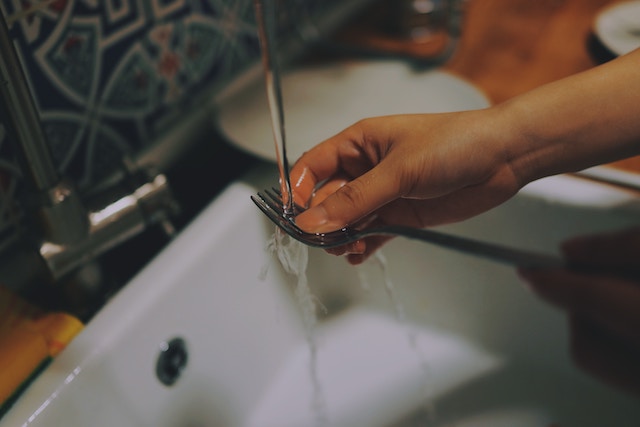Grease traps are a must have for any commercial kitchen. Cooking fats harden in the pipes, leading to a steady fat accumulation. When your kitchen doesn’t have a grease trap, the risk for sewer blockages increases tremendously.
Installing a grease trap is the first step towards a more worry-free and sustainable kitchen operation. Nevertheless, installing the device is only the beginning. The trap needs regular maintenance to keep it up and running.
A big part of the maintenance procedures consists of emptying the device from all the fats, oils, and greases (FOGs). When there are solids in the mix, you need to take care of removing these particles as well.
In this article, you’ll learn how to clean your grease trap to save you money and keep the device running in the most optimal way.
Tip #1: Don’t use the trap as a grease bin
While a grease trap does exactly as its name says, it’s better to refrain from pouring grease down the drain. Instead, use metal containers for safe storage. You can hand the containers over to the grease trap cleaning professionals when they come to conduct their regular services.
Doing so will stop the grease trap from reaching its maximum capacity too quickly. Moreover, you’ll lower the chances of having to deal with clogged drains. But make sure to use metal buckets when collecting the grease and pouring the liquid into the containers. The plastic ones can melt depending on the temperature of the grease.
Tip #2: Ensure proper installation
Not all companies are equal in terms of their work quality and commitment. Sometimes, grease traps are installed in an incorrect way. That could create a lot of issues, including the need to clean the device too frequently. All the cleaning procedures and other services may end up creating sizable expenses.

How do you spot a sub-standard installation? Here’s a list of potential signs:
- The trap doesn’t start to collect grease after its installation.
- The grease escapes the trap’s container, creating a puddle of leaked oil on the floor.
- Strange and irregular noise coming from inside the trap.
Tip #3: Eliminate solid food
Always eliminate solid food items before they reach the grease trap. The acronym FOGS stands for fats, oils, greases, and solids. While the grease trap is built for the first three particles, the amount of solid material should be minimized.
The best approach is to create a system in the kitchen that allows all the workers to easily discard solid food items. Keeping food out of the grease trap is one of the best ways to maximize the time between cleaning procedures.
In many cases, the problems with solids start from the garbage disposal. The disposal lets the food solids enter the gray water mix. In this situation, your best bet is to use a strainer. It’s a simple, yet a highly effective way to keep the excess solids out of the trap.
Tip #4: Optimize grease-related kitchen procedures
You’re able to take practical steps to manage your grease output. As a result, you’ll experience lower costs because of less frequent cleanings. Less stress on the device can increase its durability as well.
- Wipe dishes before placing them in the sink. Scraping the food solids off the dishes is a kitchen standard but giving it an extra wipe minimizes the amount of grease entering the trap.

- Reduce the amount of fat that your kitchen processes on a daily basis. Reusing the oil, if possible, helps to keep the total fat utilization under control. For example, used but clean oil could be applied to grease a baking dish.
- Baking uses less oil compared to frying. When you choose more foods that need baking over frying, you’ll see a reduction in your kitchen’s grease output. That will translate into savings on your grease trap maintenance as well.
- Clean the kitchen exhaust filters regularly. These filters regulate the vaporization of fats and oil in your kitchen.
Tip #5: Conduct regular cleaning
Routine cleaning is essential for saving money. It’s important to keep a maintenance schedule. Make sure it complies with local regulations on servicing intervals. When you use less grease, you can get the device cleaned on a more infrequent basis. But it’s still crucial to keep minimum standards for cleaning times. Even if there’s not much oil inside the tank, it will still turn rancid.
At first, it may seem that keeping the widest space possible between the cleanings reduces your costs. The reality might be different, though. As FOGs and solids break down, hydrogen sulfide gas turns into sulphuric acid, which is a very toxic substance that could damage the interceptor’s inner workings. Serious negligence could result in the requirement of entirely replacing the grease trap.
Keep track of all the maintenance. When you experience any technical issues, these logs will come in handy to see the big picture behind the problems.
The bottom line: how to save money on your grease trap cleaning?
Cleaning the grease trap is as important as owning the device in your restaurant.

Do it on a regular basis and keep a lookout for signs of decay inside the device. The red flags include strange smells and lower processing efficiency.
Keep solid food items out of the grease trap along with excess FOG particles that could be removed from the dishes before being placed in the sink. Also, if it’s possible, try to minimize the overall use of fats in your kitchen.




